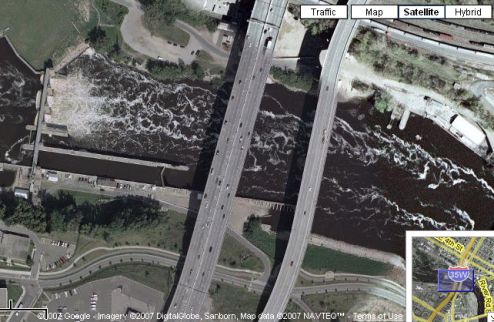If you look at any news feed in the US, whether it’s internet, cable, network, newspaper, whatever, I’m sure you’re aware of the bridge collapse in Minneapolis/St. Paul of the Interstate 35W bridge over the Mississippi river. At the moment, there is no report on a cause, and they are still recovering cars from the river this morning.  The Interstate bridge is the one on the left in this image (taken from Google Maps! thanks, Google) with eight lanes of traffic. I can’t find a reliable estimate on the daily traffic across this bridge; several sources note “between 100,000 and 200,000 vehicles per day” which is a bunch of crap. That’s such a huge range, it’s worthless. If I were forced to guess, I’d say the traffic on this bridge was around 150,000 vpd, but that is just a guess.
The Interstate bridge is the one on the left in this image (taken from Google Maps! thanks, Google) with eight lanes of traffic. I can’t find a reliable estimate on the daily traffic across this bridge; several sources note “between 100,000 and 200,000 vehicles per day” which is a bunch of crap. That’s such a huge range, it’s worthless. If I were forced to guess, I’d say the traffic on this bridge was around 150,000 vpd, but that is just a guess.
Discounting the trauma of this incident, the impact upon traffic patterns between St.Paul and Minneapolis will be huge. Interstates are built to provide the maximum mobility (ability to move long distances at speed with high numbers of vehicles per lane per hour) while the roadway next to it in the image above will be designed to permit a great deal more access (ability to link to adjacent routes and properties) which cuts down on the number of vehicles that can traverse the roadway within a given amount of time. I’m glad I don’t live on that roadway right now, it has just doubled its traffic, at least.
Once the recovery of vehicles and victims is complete, I will be interested to see how the Minnesota DOT handles the reconstruction of this bridge. There was a recent similar disaster on I-40 across the Arkansas river which killed 14 and closed I-40 for 2 months. That collapse was due to a barge collision with a bridge pier. From what I can see in the images at this website, I think there may be more involved with the reconstruction in this case, not helped by the location which is in the center of a large urban area. I doubt that the I-35W bridge was up to the current standards for bridge construction since it was constructed in 1967. Usually, putting together plans for a bridge such as this one would take at least a year, but MDOT does not have that sort of time.
I don’t currently know where the reports are, but I seem to recall that of all the tens of thousands of bridges in the US, about 50% are considered structurally deficient like this one was. “Structurally Deficient” does not mean “In danger of imminent collapse” but it does mean that the bridge in question should be upgraded or replaced on an expedited basis. Unfortunately, given the state of transportation funding across the nation, many bridges on the deficient list are being ignored due to money constraints. Also, keep in mind that the list of deficient bridges includes every single bridge in the country, including those ancient log bridges on a dirt road in the boonies. The National Highway System is usually maintained in a better-than-average condition than county roads.
More food for thought: The same list of deficient infrastructure includes dams and levees, which have a much greater chance of causing serious harm or death if they collapse.

 The Interstate bridge is the one on the left in this image (taken from Google Maps! thanks, Google) with eight lanes of traffic. I can’t find a reliable estimate on the daily traffic across this bridge; several sources note “between 100,000 and 200,000 vehicles per day” which is a bunch of crap. That’s such a huge range, it’s worthless. If I were forced to guess, I’d say the traffic on this bridge was around 150,000 vpd, but that is just a guess.
The Interstate bridge is the one on the left in this image (taken from Google Maps! thanks, Google) with eight lanes of traffic. I can’t find a reliable estimate on the daily traffic across this bridge; several sources note “between 100,000 and 200,000 vehicles per day” which is a bunch of crap. That’s such a huge range, it’s worthless. If I were forced to guess, I’d say the traffic on this bridge was around 150,000 vpd, but that is just a guess.